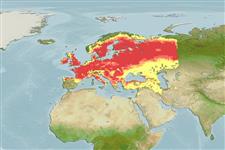Classification / Names
Common names from other countries
Main reference
Size / Weight / Age
Max length : 50.2 cm TL male/unsexed; (Ref. 88166); common length : 25.0 cm TL male/unsexed; (Ref. 556); max. published weight: 1.8 kg (Ref. 4699); max. reported age: 14 years (Ref. 41616)
Length at first maturity
Lm 14.0 range ? - ? cm
Environment
Freshwater; brackish; benthopelagic; pH range: 7.0 - 7.5; dH range: 10 - 15; potamodromous (Ref. 51243); depth range 15 - ? m
Climate / Range
Subtropical; 10°C - 20°C (Ref. 1672), preferred ?; 71°N - 36°N, 10°W - 155°E
Distribution
Europe: north to Pyrenees and Alps, eastward to Ural and Eya drainages (Caspian basin); Aegean basin in Pinios, Vardar, Vegoritis, Kastoria, Struma and Maritza drainages. Asia: Marmara basin and lower Sakarya in Anatolia, Aral basin, and Siberia from Ob eastward to Lena drainages. Naturally absent from Iberian Peninsula, Adriatic basin, Italy, Great Britain north of 56 N, Scandinavia north of 69° N. Locally introduced in Spain; introduced and invasive in northeastern Italy. At least one country reports adverse ecological impact after introduction.
Countries | FAO areas | Ecosystems | Occurrences | Introductions
Short description
Dorsal
spines
(total): 3;
Dorsal
soft rays
(total): 9-12;
Anal
spines: 3;
Anal
soft rays: 9 - 13;
Vertebrae: 39 - 41. The only species of the genus in Atlantic basin north of Pyrénées which can be distinguished from its congeners in Black and Caspian Sea basins and Apennine Peninsula by the combination of the following characters: 39-41 + 2-3 (41-44 total) scales along lateral line; dorsal and anal fins with 10½ branched rays; body laterally compressed, depth 25-35% SL; mouth terminal; snout pointed; iris from yellow in juveniles to deep red in adults; pectoral, pelvic and anal fins orange to red; and no midlateral stripe. Differs from its congeners in Balkan Peninsula by uniquely possessing 10½ branched anal rays (Ref. 59043). Caudal fin with 18-19 rays (Ref. 2196). Also Ref. 96829.
IUCN Red List Status (Ref. 115185)
Threat to humans
Potential pest (Ref. 59043)
Human uses
Fisheries: commercial; aquaculture: commercial; gamefish: yes
Tools
Special reports
Download XML
Internet sources
Estimates of some properties based on models
Phylogenetic diversity index
PD50 = 0.5020 many relatives (e.g. carps) 0.5 - 2.0 few relatives (e.g. lungfishes)
Trophic Level
3.0 ±0.0 se; Based on diet studies.
Resilience
Medium, minimum population doubling time 1.4 - 4.4 years (K=0.10-0.21; tm=2-3; tmax=12)
Vulnerability
Moderate to high vulnerability (53 of 100)
Price category
